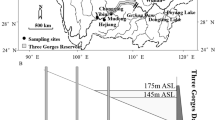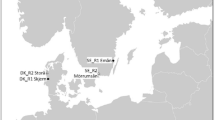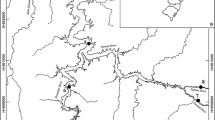Abstract
The rip-rap along an approx. 3-km-long shore in the main channel of the River Danube in Austria was completely removed to initiate the formation of a river bank through natural erosional and depositional processes. This study aimed to determine the short-term effect of this restoration measure on species composition and abundance of different developmental stages of fish at two spatial scales (micro- and mesohabitat). For this purpose, changes in abundance of early stages, as well as assemblage structure and species diversity of the benthic and the sub-littoral fish community were studied before and after restoration. No significant effects of restoration measures on the benthic fish assemblage were found. Significant and contradictory effects of the measures on the early stages and on the sub-littoral assemblage were observed. The abundance of fish larvae decreased after restoration, and this change could be attributed to the generally higher flow velocities in the new inshore microhabitats. Simultaneously, the species number and the abundance of fishes from the sub-littoral assemblage increased after restoration. This study has found that the main channel of the Danube still contain a high fish species diversity, and potentially plays a crucial role in recruitment of characteristic fluvial fishes.











Similar content being viewed by others
References
Bernhardt, E. S. & M. A. Palmer, 2011. River restoration: the fuzzy logic of repairing reaches to reverse catchment scale degradation. Ecological Applications 21(6): 1926–1931.
Bond, N. R. & P. S. Lake, 2003. Local habitat restoration in streams: constraints on the effectiveness of restoration for stream biota. Ecological Management and Restoration 4: 193–198.
Conquest, L. L., 2000. Analysis and interpretation of ecological field data using BACI designs: discussion. Journal of Agricultural, Biological and Environmental Statistics 5(3): 293–296.
Fausch, K. D., C. E. Torgersen, C. V. Baxter & H. W. Li, 2002. Landscacpes to riverscapes: bridging the gap between research and conservation of stream fishes. BioScience 52(6): 483–498.
Flore, L., H. Keckeis & F. Schiemer, 2001. Feeding, energetic benefit and swimming capabilities of 0+ nase (Chondrostoma nasus L.) in flowing water: an integrative laboratory approach. Archiv für Hydrobologie Suppl. 135(2–4): 409–424.
Flotemersch, J. E. & K. A. Blocksom, 2005. Electrofishing in boatable rivers: does sampling design affect bioassessment metrics? Environmental Monitoring and Assessment 102: 263–283.
Gore, J. A. & F. D. Shields Jr., 1995. Can large rivers be restored? BioScience 45(3): 142–152.
Górski, K., J. J. De Leeuw, H. V. Winter, D. A. Vekhov, A. E. Minin, A. Buijse & L. A. J. Nagelkerke, 2011. Fish recruitment in a large, temperate floodplain: the importance of annual flooding, temperature and habitat complexity. Freshwater Biology 56: 2210–2225.
Grossman, G. D., P. A. Rincon, M. D. Farr & R. E. Ratajczak Jr., 2002. A new optimal foraging model predicts habitat use by drift-feeding stream minnows. Ecology of Freshwater Fish 11: 2–10.
Habersack, H., M. Liedermann & M. Tritthart, 2007. Restoring large rivers – the integrated Danube river project. Proceedings of 6th International Symposium on Ecohydraulics, Christchurch, New Zealand.
Hoeinghaus, D. J., K. O. Winemiller & J. S. Birnbaum, 2007. Local and regional determinants of stream fish assemblage structure: inferences based on taxonomic vs. functional groups. Journal of Biogeography 34: 324–338.
Hohensinner, S., H. Habersack, M. Jungwirth & G. Zauner, 2004. Reconstruction of the characteristics of a natural alluvial river-floodplain system and hydromorphological changes following human modifications: the Danube River (1812–1991). River Research and Applications 20: 25–41.
Howell, T. D., A. H. Arthington, B. J. Pusey, A. P. Brooks, B. Creese & J. Chaseling, 2010. Responses of fish to experimental introduction of structural woody habitat in Riffles and Pools. Restoration Ecology. doi:101111/j.1526-100X2010.00747.x.
Humphries, P., A. J. King & J. D. Koehn, 1999. Fish, flows and flood plains: links between freshwater fishes and their environment in the Murray-Darling River system, Australia. Environmental Biology of Fishes 56: 129–151.
Jungwirth, M., 1984. Die fischereilichen Verhältnisse in Laufstauen alpiner Flüsse, aufgezeigt am Beispiel der österreichischen Donau. Österreichische Wasserwirtschaft. Jahrgang 36. Heft 5/6: 103–111.
Keckeis, H., G. Winkler, L. Flore, W. Reckendorfer & F. Schiemer, 1997. Spatial and seasonal characteristics of 0+ fish nursery habitats of nase, Chondrostoma nasus in the river Danube, Austria. Folia Zoologica 46(Suppl. I): 133–150.
Keckeis, H. & F. Schiemer, 2002. Understanding conservation issues of the Danube River. In Fuiman, L. A. & R. G. Werner (eds), Fishery Science. The Unique Contributions of Early Life Stages. Blackwell Science: 272–288.
King, A. J., P. Humphries & P. S. Lake, 2003. Fish recruitment on floodplains: the roles of patterns of flooding and life history characteristics. Canadian Journal of Fisheries and Aquatic Sciences 60(7): 773–786.
King, A. J., Z. Tonkin & J. Mahoney, 2009. Environmental flow enhances native fish spawning and recruitment in the Murray River, Australia. River Research and Applications 25: 1205–1218.
Klasz, G., N. Krouzecky, W. Reckendorfer, R. Schmalfuß & R. Schlögl, 2009. New hydro-engineering approaches: river bank renaturation and groyne redesign along the Danube east of Vienna. Österreichische Ingenieur- und Architekten-Zeitschrift 154(1–6): 1–10.
Lake, P. S., N. Bond & P. Reich, 2007. Linking ecological theory with stream restoration. Freshwater Biology 52: 597–615.
Loisl, F., G. Singer & H. Keckeis. (submitted, in this volume). Structure and diversity of fish assemblages in different reaches of the main channel of the Danube in Austria. Hydrobiologia.
McCune, B. & J. B. Grace, 2002. Analysis of Ecological Communities. MjM Software Design, Gleneden Beach, Oregon: 300 pp.
Melcher, A., S. Schmutz & G. Haidvogl, 2007. Spatially based methods to assess the ecological status of European fish assemblage types. Fisheries Management and Ecology 14: 453–463.
Minns, C. K., J. R. M. Kelso & R. G. Randall, 1996. Detecting the response of fish to habitat alterations in freshwater ecosystems. Canadian Journal of Fisheries and Aquatic Sciences 53(Suppl. 1): 403–414.
Muhar, S., S. Schmutz & M. Jungwirth, 1995. River restoration concepts – goals and perspectives. Hydrobiologia 303(1–3): 183–194.
Palmer, M. A., E. S. Bernhardt, J. D. Allan, P. S. Lake, G. Alexander, S. Brooks, J. Carr, S. Clayton, C. N. Dahm, J. Jollstad Shah, D. L. Galat, S. G. Loss, P. Goodwin, D. D. Hart, B. Hassett, R. Jenkinson, G. M. Kondolf, R. Lave, J. L. Meyer, T. K. O′Donnel, L. Pagano & E. Sudduth, 2005. Standards for ecologically successful river restoration. Journal of Applied Ecology 42: 208–217.
Persat, H. & G. H. Copp, 1989. Electrofishing and point abundance sampling for the ichthyology of large rivers. In Cowx, I. (ed), Developments in Electrofishing, Fishing News Books. Blackwell Scientific, Oxford: 203–215.
Reckendorfer, W., R. Schmalfuss, C. Baumgartner, H. Habersack, S. Hohensinner, M. Jungwirth & S. Schiemer, 2005. The integrated river engineering project for the free-flowing Danube in the Austrian alluvial zone National Park: contradictory goals and mutual solutions. Archiv für Hydrobiologie Suppl. 155(1-4): 613–630.
Schiemer, F. & T. Spindler, 1989. Endangered fish species of the Danube River in Austria. Regulated Rivers: Research & Management 4: 397–407.
Schiemer, F. & H. Waidbacher, 1992. Strategies of conservation of a Danubian fish fauna. In Boon, P. J., P. Calow & G. E. Petts (eds), River Conservation and Management: 363–382.
Schiemer, S., T. Spindler, H. Wintersberger, A. Schneider & A. Chovanec, 1991. Fish fry associations: important indicators for the ecological status of large rivers. Verhandlungen des Internationalen Verein Limnologie 24: 2497–2500.
Schiemer, F., M. Jungwirth & G. Imhof, 1994. Die Fische der Donau-Gefährdung und Schutz. Ökologische Bewertung der Umgestaltung der Donau. Grüne Reihe des Bundesministeriums für Umwelt, Jugend und Familie. Band 5. Styria Verlag: 160 pp.
Schiemer, F., C. Baumgartner & K. Tockner, 1999. Restoration of floodplain riveres: the “Danube Restoration Project”. Regulated Rivers: Research & Management 15: 231–244.
Schiemer, F., G. Guti, H. Keckeis & M. Staras, 2005. Ecological status and problems of the Danube River and its fish fauna: a review. In Welcome, R. L., and T. Petr (eds), Proceedings of the Second International Symposium on the Management of Large Rivers for Fisheries, Vol. 1, pp. 273–299.
Schlosser, I. J., 1987. The role of predation in age-and size-related habitat use by stream fishes. Ecology 68(3): 651–659.
Smith, E. P., 2002. BACI design. In: El-Shaarawi, A. H. & W. W. Piegorsch (eds), Encyclopedia of Environmetrics, Vol. 1. John Wiley & Sons, Ltd, Chichester: 141–148.
Smith, E. P., D. R. Orvos & J. Cairns Jr., 1993. Impact assessment using the before-after-control-impact (BACI) model: concerns and comments. Canadian Journal of Fisheries and Aquatic Sciences 50: 627–637.
Stranko, S. A., R. H. Hildebrand & M. A. Palmer, 2011. Comparing the fish and benthic macroinvertebrate diversity of restored urban streams to reference streams. Restoration Ecology. doi:10.1111/j.1526-100X.2011.00824.x.
Tockner, K., F. Schiemer & J. V. Ward, 1998. Conservation by restoration: the management concept for a river-floodplain system on the Danube River in Austria. Aquatic Conservation: Marine and Freshwater Ecosystems 8: 71–86.
Tockner, K., F. Schiemer, C. Baumgartner, G. Kum, E. Weigand, I. Zweimüller & J. V. Ward, 1999. The Danube Restoration Project: species diversity patterns across connectivity gradients in the floodplain system. Regulated Rivers: Research and Management 15: 245–258.
Ugland, K. I., J. S. Gray & K. E. Ellingsen, 2003. The species-accumulation curve and estimation of species richness. Journal of Animal Ecology 72: 888–897.
Waidbacher, H., 1989. Veränderungen der Fischfauna durch Errichtung des Donaukraftwerkes Altenwörth. In: Ökosystemstudie Donaustau Altenwörth, Veröffentlichungen des öst. MaB-Programms, Universitätsverlag Wagner – Innsbruck: 124–161.
Waidbacher, H. & G. Haidvogl, 1998. Fish migration and fish passage facilities in the Danube: past and present. In: Jungwirth, M., S. Schmutz, S. Weiss (eds), Fish Migration and Fish Bypasses. Fishing News Books. Blackwell Science: 85–98.
Wiesner, C., 2005. New records of non-indigenous gobies (Neogobius spp.) in the Austrian Danube. Journal of Applied Ichthyology 21(4): 324–327.
Winkler, G., H. Keckeis, W. Reckendorfer & F. Schiemer, 1997. Temporal and spatial dynamics of 0+ Chondrostoma nasus, at the inshore zone of a large river. Folia Zoologica 46(Suppl.1): 151–168.
Wolfram, G. & E. Mikschi, 2007: Rote Liste der Fische (Pisces) Österreichs. In Zulka, K. P. (Red.): Rote Liste gefährdeter Tiere Österreichs, Teil 2. Grüne Reihe des Lebensministeriums Band 14/2. Böhlau-Verlag, Wien, Köln, Weimar: 61–198.
Zauner, G., C. Ratschan & M. Mühlbauer, 2007. Fischfauna der Donau im östlichen Machland unter besonderer Berücksichtigung der FFH-Schutzgüter und ihres Erhaltungszustands; Maßnahmen und Potenzial für Revitalisierungen. Österreichs Fischerei 60: 194–206.
Zeug, S. C. & K. O. Winemiller, 2008. Relationships between hydrology, spatial heterogeneity and fish recruitment dynamics in a temperate floodplain river. River Research and Applications 24: 90–102.
Acknowledgments
This study was financed by the LIFE Project LIFE02 NAT/A/008518 “Donauufer-Restoration of Danube river banks” and coordinated by the Nationalpark Donau-Auen GmbH and the viaDonau. I am grateful to Simon Götsch and Vinzenz Bammer for their help in the field work. T. Kaminskas improved the English. This article was improved by suggestions of P. Humphries, A. Lechner, and two anonymous reviewers.
Author information
Authors and Affiliations
Corresponding author
Additional information
Guest editors: H. Habersack, S. Muhar & H. Waidbacher / Impact of human activities on biodiversity of large rivers
Rights and permissions
About this article
Cite this article
Keckeis, H. Short-term effects of inshore restoration measures on early stages, benthic species, and the sublittoral fish assemblage in a large river (Danube, Austria). Hydrobiologia 729, 61–76 (2014). https://doi.org/10.1007/s10750-013-1485-x
Received:
Accepted:
Published:
Issue Date:
DOI: https://doi.org/10.1007/s10750-013-1485-x




